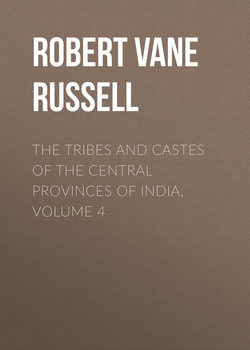Читать книгу The Tribes and Castes of the Central Provinces of India, Volume 4 - Robert Vane Russell - Страница 98
Part II
Articles on Castes and Tribes
Kumhār—Yemkala
Vol. IV
Lodhi
3. Sub-divisions
ОглавлениеIn the northern Districts the landholding Lodhis are divided into a number of exogamous clans who marry with each other in imitation of the Rājpūts. These are the Mahdele, Kerbania, Dongaria, Narwaria, Bhadoria and others. The name of the Kerbanias is derived from Kerbana, a village in Damoh, and the Bālākote family of that District are the head of the clan. The Mahdeles are the highest clan and have the titles of Rāja and Diwān, while the others hold those of Rao and Kunwar, the terms Diwān and Kunwar being always applied to the younger brother of the head of the house. These titles are still occasionally conferred by the Rāja of Panna, whom the Lodhi clans looked on as their suzerain. The name of the Mahdeles is said to be derived from the mehndi or henna plant. The above clans sometimes practise hypergamy among themselves and also with the other Lodhis, taking daughters from the latter on receipt of a large bridegroom-price for the honour conferred by the marriage. This custom is now, however, tending to die out. There are also several endogamous subcastes ranking below the clans, of whom the principal are the Singrore, Jarha, Jāngra and Mahālodhi. The Singrore take their name from the old town of Singraur or Shrengera in northern India, Singrore, like Kanaujia, being a common subcaste name among several castes. It is also connected more lately with the Singrām Ghat or ferry of the Ganges in Allahābād District, and the title of Rāwat is said to have been conferred on the Singrore Lodhis by the emperor Akbar on a visit there. The Jarha Lodhis belong to Mandla. The name is probably a form of Jharia or jungly, but since the leading members of the caste have become large landholders they repudiate this derivation. The Jāngra Lodhis are of Chhattīsgarh, and the Mahālodhis or ‘Great Lodhis’ are an inferior group to which the offspring of irregular unions are or were relegated. The Mahalodhis are said to condone adultery either by a man or woman on penalty of a feast to the caste. Other groups are the Hardiha, who grow turmeric (haldi), and the Gwālhare or cowherds. The Lodhas of Hoshangābād may also be considered a separate subcaste. They disclaim connection with the Lodhis, but the fact that the parent caste in the United Provinces is known as Lodha appears to establish their identity. They abstain from flesh and liquor, which most Lodhis consume.
This division of the superior branch of a caste into large exogamous clans and the lower one into endogamous subcastes is only found, so far as is known, among the Rājpūts and one or two landholding castes who have imitated them. Its origin is discussed in the Introduction.
